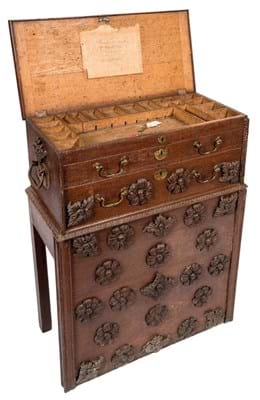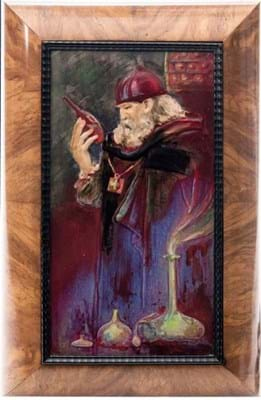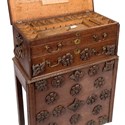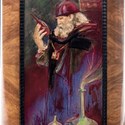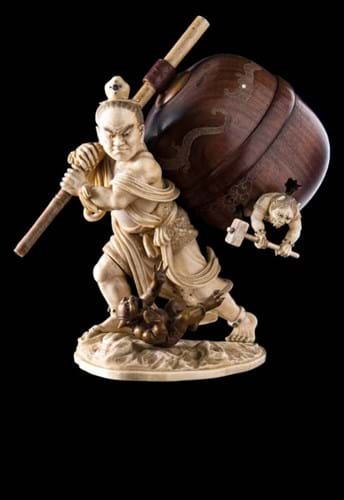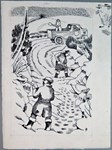Decorated to the drawers and stand with applied carved flowerheads and paterae, the 2ft 9in (79cm wide) chest had a fitted interior below the hinged lid, iron handles to the sides and bore a paper label: London 17__. Bought of James Buttall, Ironmonger and Brazier at the Gridiron near Hungerford Market in the Strand.
Estimated at £300-500, it sold at £3300 to the London trade at the January 22-24 sale at Exeter.
Best of the furniture proper was a set of four early 19th century Hepplewhite style mahogany shield-back open armchairs which went a shade over estimate at £3200.
A walnut and parcel-gilt architectural wall mirror had been catalogued as 19th century in the George II-style but was considered by some to be a period piece.
Standing 4ft 3in tall x 1ft 11in wide (1.30m x 60cm), it had an acanthus-decorated broken pediment centred by a palmette spray, and a similar palmette and acanthus scroll frieze.
It sold at £5400 (estimate £400- 600) to the southern English trade.
Covering most collecting areas
The 1080-lot sale opened with 125 lots of 18th century English porcelain which will be discussed in a future issue, but the three days encompassed most areas of collecting.
Appealing to a different type of ceramics collector was a large early 20th century Doulton tile by factory art director Charles Noke.
It depicted an alchemist in his workshop – a fitting subject for a man who pioneered so many different glazes at Royal Doulton.
Housed within a 16in (40cm) ebony-trimmed cushion walnut frame, the tile formed the hinged door to a decanter box fitted with brackets for wall hanging. A concealed button revealed two slender spirit decanters.
It attracted strong Australian interest before selling to a UK dealer at £4000, 10 times the top estimate.
Silver signs of the times
A comment on the times was to see the work of a mid-18th century London Huguenot silversmith matched by currently in-demand early 20th century Chinese silver.
Pierre Gillois is a highly regarded name and the set of three tea caddies he made in 1754-56 were sophisticated examples with a bombé outline, shallow dome lift-off lids and cast strawberry finials. Offered in a Victorian rosewood fitted box, they sold to the trade at £2500.
A conservative estimate of £400- 600 reflected a missing foot.
The Chinese entry was a circular tray by Wang Hing & Co of Hong Kong. It was undated in the catalogue but was probably from the 1920s when the Cantonese firm, which had been producing export silver since the 1840s, opened a flagship shop in the then colony.
Decorated to the centre with cranes among bamboo shoots and flowering shrubs and enclosed by a pierced gallery border, the 10in (26cm) diameter tray weighing 23oz was estimated at £500-700 and sold back to China at £1850.
Japanese best-sellers
Best-sellers among the Eastern works of art, however, came not as usual from China, but from Japan.
A 16in high x 2ft 8in long (41 x 82cm) bronze of a tiger with two cubs signed by the Meiji sculptor Akasofu Gyoko went above estimate at £4100 to the southern English trade against strong Japanese interest.
Another Japanese eye-catcher was an 8in (20cm) high ivory and boxwood Meiji okimono.
Signed to a red lacquered tablet Kyokusui, the okimono, illustrated on this page, depicted the temple guardian Nio slaying demons.
It went to a UK-based Oriental specialist at £4000 against an estimate of £1500-1800.


